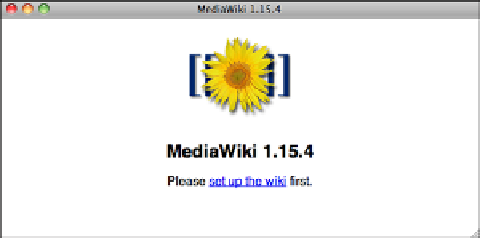HTML and CSS Reference
In-Depth Information
used to apply inline tags as well as block-level tags. As you can see, I used
'''
to make
some text bold, and I created an outbound link from the wiki. You can also use
MediaWiki markup to create tables, include images in pages, and take on most of the
other tasks that you can accomplish with HTML. There's a guide to MediaWiki's
markup language at the following page:
22
This is a wiki page, and if you had some information to add to the discussion of wiki
markup, you could add it.
Downloading and Installing MediaWiki
The download and installation process for MediaWiki is similar to the process for
WordPress. To download the software, go to
http://www.mediawiki.org/wiki/Download.
Find the most recent release and download that archive. After you've expanded the
archive, rename the folder, which probably has a name such as
mediawiki-1.15.4
. The
name you give it will appear in the URL, so you probably want to pick
mediawiki
or just
wiki
. Upload or copy all the files into the document root of your server (or into the
directory where you want the wiki to reside), and then go to the URL where you just
uploaded the files. You'll see a page like the one in Figure 22.10, which indicates that
you need to go through the MediaWiki installation process.
FIGURE 22.10
MediaWiki needs
to be installed.
When you click the Setup link, the MediaWiki install script checks to make sure your
server is configured properly and has the software that you need for MediaWiki to work.
It also asks you to answer a few questions. Some are easy, such as the name of the site
and the email address for the person running the site. Others are not so easy, such as the
caching configuration. You can safely choose No Caching for that one.
If MediaWiki is able to write to your configuration files (based on the permissions on
those files and the privileges that the web server runs with), it allows you to enter all


